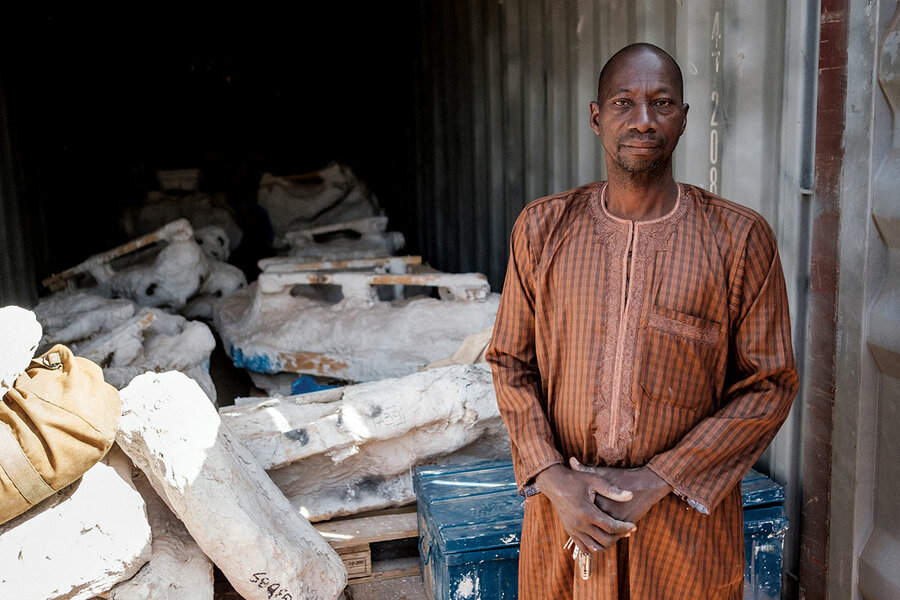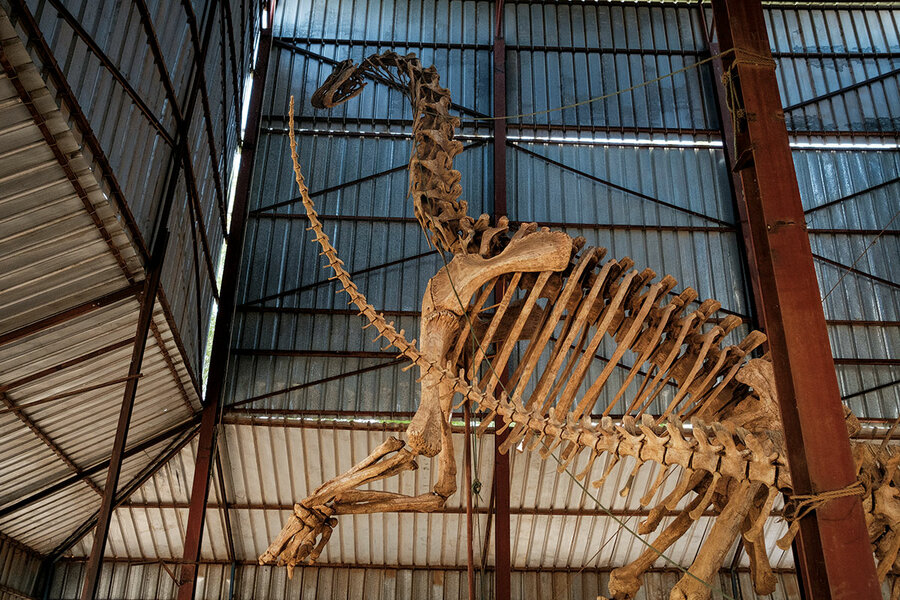Can 50 tons of dinosaur fossils help hatch paleontology in Niger?
Loading...
| Niamey, Niger
A trove of dinosaur bones, soon to be shipped from Niger to the University of Chicago for research, represent paleontology’s latest win.
The fossils include ancient mammals, flying reptiles, a 40-foot crocodile, and “a dozen large dinosaurs that are new, including huge 60-footers,” says American paleontologist Paul Sereno.
Why We Wrote This
A story focused onLandlocked Niger is home to stunning dinosaur fossils. Scientists aim not only to find them but also to build homegrown research expertise.
But Chicago won’t be the bones’ final resting place. They are earmarked to be eventually returned to Niger, which contains some of the richest paleontological finds in Africa but boasts no paleontologists of its own.
Niger Heritage is a project drawn up by Dr. Sereno, archaeologist Boubé Adamou, and other researchers and government officials. It envisions museums with the capacity to not just display the fossils but also, for the first time, conduct homegrown research.
“Each time, we see that we find new dinosaurs, new fossils that permit us to say that the soil is rich,” says Mr. Adamou, an archaeologist at the Institute for Research in Human Sciences who, as one of Niger’s foremost experts on excavations, helped lead a recent expedition. “Niger has an unheard-of heritage.”
Niger’s first paleontologists, it is hoped, might be in undergraduate courses right now.
Goats, cows, and pedestrians wander by the two unassuming shipping containers along a street in Niger’s riverside capital without a second thought. But inside lie nearly 50 tons of dinosaur bones wrapped in plaster – potentially some of the most significant paleontological finds this landlocked West African country, and even the continent, has ever known.
There are fossils from perhaps as many as 100 different species, some of them from ancient animals never seen before.
“Small animals, mammals, flying reptiles, turtles” as well as a 40-foot crocodile and “a dozen large dinosaurs that are new, including huge 60-footers,” says American paleontologist Paul Sereno.
Why We Wrote This
A story focused onLandlocked Niger is home to stunning dinosaur fossils. Scientists aim not only to find them but also to build homegrown research expertise.
Getting them to the capital was years in the making – and their journey isn’t over. The initial discoveries were made in 2018 and 2019, in the vast expanse of the Sahara Desert. It would take time and funding for a proper dig, though, so the paleontologists covered them up and buried them, hoping the winds wouldn’t expose them to curious nomads or dangerous smugglers.
Then COVID-19 hit, shutting everything down until finally, last fall, Professor Sereno could return to unearth the fossils again.
“Niger is going to tell Africa’s story during the dinosaur era,” he says. Instead of the fossilized snapshots found in many other places, these discoveries present a continuum of “the Jurassic and Cretaceous history of Africa.”
The bones, soon to be shipped to Dr. Sereno’s lab at the University of Chicago for research, represent paleontology’s latest win against the harsh desert environment of Niger, which is home not only to fossils but also to soaring temperatures, shifting dunes, and various armed groups.
But Chicago won’t be the bones’ final resting place. The fossils are earmarked to be eventually returned to Niger, where the kernels of a formal paleontology sector are being planted in a country that contains some of the richest paleontological finds in Africa but boasts no paleontologists of its own, or even academic programs dedicated to the field.
“Each time, we see that we find new dinosaurs, new fossils that permit us to say that the soil is rich – unlike other countries, and other continents,” says Boubé Adamou, an archaeologist at the Institute for Research in Human Sciences who, as one of Niger’s foremost experts on excavations, helped lead this most recent expedition. “Niger has an unheard-of heritage.”
A race in the desert
In a convoy speeding through the desert last fall, the team of about 20 found themselves massively outnumbered by scores of armed men riding in machine gun-mounted trucks. Those were just their guards, determined to keep this modern-day Saharan caravan safe from smugglers or bandits roving the dunes. Dr. Sereno declines to disclose the exact number of the guards, to not give away sensitive security measures.
The team, composed of researchers and students from the United States, Niger, and Europe, went to three dig sites over three months. By the time they finished in December, they had unearthed everything from an Ouranosaurus with a 25-foot-long, bony “sail” across the length of its back to the 6-foot thigh bone of a long-necked sauropod.
How was it that what is now one of the world’s largest deserts sustained so much life? Millions of years ago, the vast expanses of Niger were anything but dry, as rivers, wetlands, and lakes stretched across what researchers called the Green Sahara, home at one point to dinosaurs, and later, ancient human civilizations with embalming techniques that predate the Egyptians – relics of which were also found on the fall expedition.
But geologic happenstance also created this modern dinosaur jackpot. Most dinosaur fossils in the world are found in the U.S. and Asia because mountain ranges rose over millions of years, slowly pushing up earth over time and burying bones below. Niger’s mountains provided the same process. A second key factor here, as in places like Montana, is the lack of forest or jungle to inhibit the search for bones.
A hundred million years since the dinosaurs’ heyday, it’s easy to see why Niger remains off the beaten path for paleontologists, despite its riches. As one of the poorest nations on Earth, it combines rough infrastructure with harsh desert conditions.
But even if the Green Sahara is a thing of the past, the desert today is anything but desolate. Local nomads who’ve long mastered the difficult terrain have become key to conducting paleontology there, spotting bones and leading expeditions through otherwise unnavigable desert expanses. While the pandemic held Dr. Sereno’s team at bay, nomads kept a watchful eye on the carefully buried treasures, texting him updates.
Growing local paleontologists
In Niamey, children and families dart around the Boubou Hama National Museum and adjacent zoo, checking out hippos and hyenas, and walking in the shadows of two massive dinosaur skeletons on display, including a terrifying 36-foot-tall carnivore called a Suchomimus. An equally menacing Afrovenator greets visitors at the airport, along with the skull of a “super croc.”
But these are just replicas. In addition to lacking paleontologists, Niger doesn’t have the proper facilities to display actual fossils, Mr. Adamou says.
That could be changing. Niger Heritage is a project drawn up by Dr. Sereno, Mr. Adamou, and coterie of international and Nigerien researchers and government officials. It envisions two museums – one in Agadez, in the Sahara Desert, and one in Niamey – with the capacity to not just display the fossils but also, for the first time, conduct homegrown research. The plans go beyond dinosaurs, covering the prehistoric human era, Niger’s modern nomadic heritage, and today’s climate and ecological issues.
“The health of the [Niger River], the advance of the desert – they’re wrapped up in these projects that take you [on] a walk through time, and then they engage subject matter that is absolutely critical to everyday life,” says Dr. Sereno, who is dedicating time this year to raise funds for the $300 million museum project.
Already, three small museums have launched as part of a local education initiative.
The Agadez and Niamey museums, and accompanying funds for local universities, are meant to attract international academic interest and tourism as well as to support local research. Niger’s first paleontologists, it is hoped, might be in undergraduate courses right now. With the right guidance and funding – to do Ph.D. programs outside the country – they could start correcting the lopsided nature of paleontology, where resources and opportunities are concentrated in rich countries.
“The difficulty lies in not being able to use this heritage,” says Mawli Dayak, an adviser to Niger’s president. “For education, for teaching, for culture, or for Niger in general.” But he adds that Niger Heritage has drummed up attention around Niger’s paleontological potential, and “there are a lot of young people who are interested in these questions.”
If Niger can grow its local paleontologists, says Sidi Abdella, logistics manager for Niger Heritage, “Niger will be among the biggest countries” for paleontology.
Perhaps just as important, though, is developing pride among ordinary Nigeriens in their country’s stewardship.
“We can showcase this patrimony,” says Mr. Abdella. “We can say Niger is taking care of it.”










